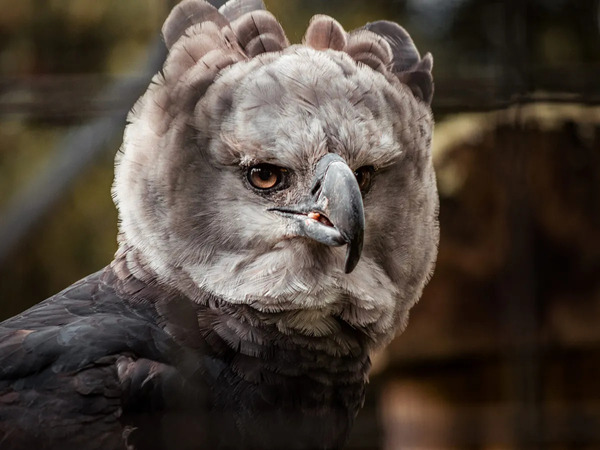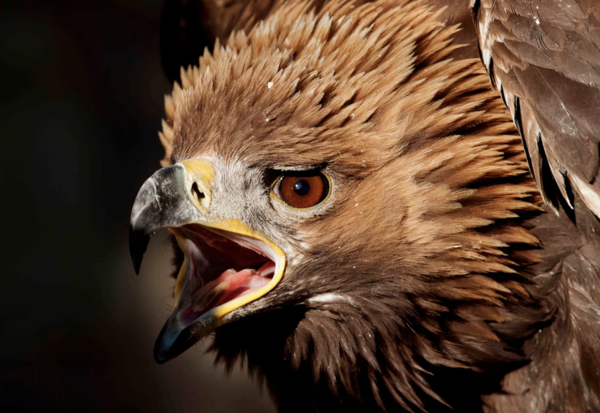The harpy eagle (Harpia harpyja) stands as one of the most powerful and formidable raptors on the planet. Known for its incredible strength, commanding presence, and sharp hunting abilities, this majestic bird rules the skies of the rainforests it inhabits. In this article, we delve into the harpy eagle’s impressive characteristics, highlighting its power, size, aggressive nature, and the current conservation status of this magnificent creature.

The harpy eagle is often hailed as the strongest eagle on Earth, a title it holds with great authority. Its powerful build is a key aspect of its dominance in the wild. Adult harpy eagles can weigh between 6 to 10 kilograms (13 to 22 pounds), with females being larger and heavier than males. With a wingspan of up to 2 meters (6.5 feet), this bird has the size and strength to hunt large prey, such as monkeys, sloths, and even small deer.
One of the most distinctive features of the harpy eagle is its massive talons. The rear talon can grow up to 4 inches long—roughly the size of a grizzly bear’s claws. These talons are designed to exert tremendous pressure, allowing the eagle to swiftly subdue prey in mid-air. The sheer power of the harpy eagle’s grip has been measured at over 50 kilograms of force, which is enough to crush bones with ease. Such strength places the harpy eagle at the top of its food chain, with very few natural competitors.
In addition to its size and strength, the harpy eagle is known for its aggressive nature when hunting. Unlike many birds of prey that rely on speed or stealth, the harpy eagle uses brute force to overpower its targets. Its hunting technique is often described as ambush predation. The eagle will wait patiently on a high perch before launching a surprise attack on unsuspecting prey below.
Once it strikes, the harpy eagle’s speed and precision are unmatched. Its ability to navigate through dense forests without losing momentum is a testament to its agility, despite its large frame. When pursuing prey, the harpy eagle often flies just above the canopy, diving swiftly when it spots movement, grabbing its prey in mid-flight or plucking it from the trees with unparalleled precision.
The harpy eagle's native habitat spans from Mexico down through Central and South America, with the majority of its population residing in the rainforests of Brazil, Panama, and Colombia. Harpy eagles prefer lowland tropical rainforests, particularly areas with dense, tall trees, where they can find ample prey and nesting opportunities. These birds are often seen at altitudes of up to 2,000 meters (6,500 feet), although they tend to prefer lower elevations.
Due to its reliance on large tracts of undisturbed forest, the harpy eagle is highly sensitive to habitat destruction. Deforestation and human encroachment have drastically reduced its population in many regions. The ongoing loss of rainforest habitat poses a significant threat to the survival of this species, as it limits both its hunting grounds and nesting sites.
The harpy eagle is currently classified as Near Threatened on the International Union for Conservation of Nature (IUCN) Red List. Though not yet critically endangered, its population is in decline due to factors such as deforestation, poaching, and habitat fragmentation. Estimates suggest that there are fewer than 50,000 individuals remaining in the wild, with some populations being more at risk than others.
Conservation efforts are underway to protect the harpy eagle, including habitat restoration projects and breeding programs in captivity. In countries like Brazil and Panama, the harpy eagle has become a symbol of conservation, with several organizations working to educate the public about the importance of preserving this apex predator. Protecting its natural habitat is crucial to ensuring the survival of the species.
As an apex predator, the harpy eagle plays a crucial role in maintaining the balance of its ecosystem. By preying on species such as monkeys, sloths, and large birds, it helps regulate the populations of these animals, preventing overgrazing and ensuring that the rainforest remains diverse and healthy. The loss of the harpy eagle could result in cascading effects throughout the ecosystem, disrupting the delicate balance of the food chain.

The harpy eagle, with its imposing size, aggressive hunting tactics, and unmatched strength, truly lives up to its reputation as the strongest eagle on Earth. However, despite its dominance in the wild, the harpy eagle faces significant challenges in the modern world. Deforestation and habitat loss threaten its survival, making it more important than ever to protect this awe-inspiring species.
Conservation efforts are key to preserving the harpy eagle for future generations. By raising awareness about the threats it faces and implementing sustainable land-use practices, we can help ensure that this magnificent raptor continues to reign supreme in the skies above the world’s tropical rainforests.

Both the harpy eagle and the golden eagle are impressive birds of prey, but they have distinct characteristics that set them apart. Below is a comparative analysis to determine which eagle stands out in various aspects.
| Feature | Harpy Eagle | Golden Eagle |
|---|---|---|
| Scientific Name | Harpia harpyja | Aquila chrysaetos |
| Weight | 6 to 10 kg (13 to 22 lbs) | 3 to 6.5 kg (6.6 to 14.3 lbs) |
| Wingspan | Up to 2 m (6.5 ft) | 1.8 to 2.3 m (5.9 to 7.5 ft) |
| Habitat | Tropical rainforests | Mountains, hills, and open areas |
| Prey Size | Large mammals (monkeys, sloths) | Medium-sized mammals (rabbits, foxes) |
| Hunting Technique | Ambush predator | Soaring and stooping |
| Aggressiveness | Very aggressive | Aggressive but less so than harpy |
| Conservation Status | Near Threatened | Least Concern |
| Geographical Range | Central and South America | Northern Hemisphere (Europe, Asia, North America) |

In terms of sheer strength and size, the harpy eagle takes the lead, especially with its capability to hunt larger prey. However, the golden eagle showcases remarkable versatility and is adept in a variety of habitats. Both species are incredible in their own right, but the harpy eagle reigns supreme when it comes to power and dominance in its specific environment.
animal tags: Harpy-Eagle Golden-Eagle
We created this article in conjunction with AI technology, then made sure it was fact-checked and edited by a Animals Top editor.